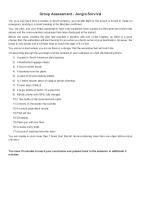Case Study Importing, Exporting - Exporting Desserts [PDF]
Case Study Exporting Desserts The opening line of the “About” section of Lulu’s Dessert’s website—www. lulusdessert.com—
36 0 40KB
Papiere empfehlen
![Case Study Importing, Exporting - Exporting Desserts [PDF]](https://vdoc.tips/img/200x200/case-study-importing-exporting-exporting-desserts.jpg)
- Author / Uploaded
- Saqib Ali
Datei wird geladen, bitte warten...
Zitiervorschau
Case Study Exporting Desserts The opening line of the “About” section of Lulu’s Dessert’s website—www. lulusdessert.com—is “pull up a chair and join in the festival of flavors with Lulu’s Gelatin Desserts,”* Taking basic ingredients and creating a myriad of flavors has led to worldwide exporting success for Lulu’s Dessert Corporation. Started in 1982 in a 700-square-foot storefront in Torrance, California, followed by exporting to Mexico in 1992, the company is a gelatin dessert business with core customer target markets in the United States and Mexico but with exporting to several countries worldwide. Lulu is the nickname of the founder, Maria de Lourdes Sobrino. “Lulu” thought of the idea of ready-to-eat flavored gelatin desserts when she was looking for the popular dessert in local stores. At the time, she was living in the United States, but originally she came from Mexico. The ready-to-eat flavored gelatin desserts were a staple in her native Mexico, but the concept was a novelty when she introduced it to American grocers. Today, Lulu’s Desserts can be found in a variety of well-known stores (e.g., Albertsons, Safeway, Walmart). Back in the early 1980s, Lulu identified and recognized a need for gelatin desserts, filled it with what has now become 45 ready-to-eat products of different sizes and flavors, and transformed the food industry by creating the first ready-to-eat gelatin category based largely on her mother’s recipes. The business concept has become quite a “spoon spectacular” since Lulu first began, with a catch line for the company of “more fun for your spoon.” The party started out very small with just Lulu making her mother’s gelatin recipe desserts, with an initial production of 300 cups of gelatin per day. Ultimately, the party grew so big that Lulu could not handle it by herself and had to negotiate help from established markets and wholesale distributors. Lulu wanted everyone within reach to enjoy her festival of flavors. In going international, Lulu spent some 10 years trying to gain international sales but continued to run into all kinds of problems and issues. After the trial-and-error decade, she found assistance from the U.S. Export Import Bank services and now has deeper confidence in her abilities to export products worldwide. Over the years, Lulu has kept making more and more varieties of her gelatin desserts. A carnival of colors of three-layer gelatins, fruit parfaits, and festive containers of wild new colors and flavors have become identifying marks. This exporting innovation led Bill Hopkins of USA Today to call Maria de Lourdes Sobrino “the queen of ready-to-eat gelatins and a force in the surging number of Hispanic Entrepreneurs.”** Hal Lancaster of the Wall Street Journal also recognized her as an innovator and very successful entrepreneur in “getting out and selling customers your dream.”*** Today, with its exporting worldwide but especially to Mexico and sales across the United States, Lulu’s Dessert’s core focus is on five product categories, including the original Mexican gelatin cup, rice pudding Mexican-style cup, the original creamy gelatin cup, parfait treats gelatin cups, and caramel flan cups. The flavors include such exotic descriptors as Fruit Fantasia, Orange Blast, Creamy Vanilla with Cinnamon, and Sugar Free-De-Light.
CASE DISCUSSION QUESTIONS 1. Desserts are often very localized in taste. Beyond the United States and Mexico, where do you think Lulu’s Dessert products would be favorable received by customers? 2. Lulu’s Dessert used the U.S. Export-Import Bank services to help with knowledge and market segmentation for her desserts as a part of exporting the company products. The Ex-Im Bank receives lots of positive and negative reviews in the United States; do you think it is helpful that the United States has an export-import bank to assist U.S. companies? 3. Do you think franchising is a foreign market entry option for Lulu’s Dessert? Why or why not?









